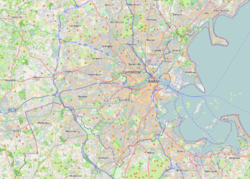
The First Parish Church is a historic church at 50 Church Street in Waltham, Massachusetts, whose Unitarian Universalist congregation has a history dating to c. 1696. The current meeting house was built in 1933 after a fire destroyed the previous building on the same site. It is a Classical Revival structure designed by the nationally known Boston firm of Allen & Collens. The church building was listed on the National Register of Historic Places in 1989.

St. Charles Borromeo Church is a former parish of the Catholic Church in Waltham, Massachusetts. It is noted for its historic church building, completed in 1922. A high quality example of Italian Renaissance Revival architecture, it is emblematic of the shift on Waltham's south side from a predominantly Protestant population to one of greater diversity. The building was listed on the National Register of Historic Places in 1989.

The Terence Dolan House is a historic house at 478 Prospect Street in Methuen, Massachusetts, United States. Built in 1900, it is a high-style local example of Colonial Revival architecture. The house was listed on the National Register of Historic Places in 1984.
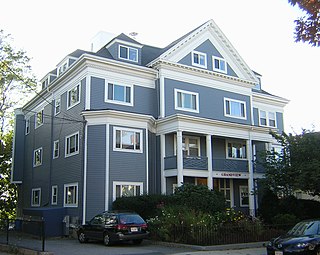
The Grandview is a historic apartment hotel at 82 Munroe Street in Somerville, Massachusetts. This type of building was not uncommon in the city at the time of its 1896 construction. This building affords commanding views of the Boston area from its site near the top of Prospect Hill, and has well-preserved Colonial Revival styling. The building was listed on the National Register of Historic Places in 1989.

The United States Watch Company is a historic factory complex at 260 Charles Street in Waltham, Massachusetts. Built in 1886 and enlarged in 1901, it represents one of the most successful spinoffs of the American Waltham Watch Company, Waltham's dominant watchmaker of the late 19th century. When the complex was listed on the National Register of Historic Places in 1989, it was the last watch factory left in the city.

The William Gibbs House is a historic house in Waltham, Massachusetts. Built c. 1830–54, this 2+1⁄2-story wood-frame house is one Waltham's few temple-front Greek Revival houses. It has four two-story Corinthian columns supporting a fully pedimented gable with a deep, dentillated cornice. It was probably built in the 1840s by William Gibbs, a hat manufacturer, and was sold by him to another hat maker who lost it to foreclosure.

The Wellington–Castner House is a historic house in Waltham, Massachusetts. The house was listed on the National Register of Historic Places in 1989.
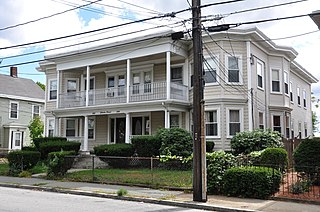
The building at 202–204 Charles Street in Waltham, Massachusetts is a well-preserved example of multi-unit residential housing built in the city in the early decades of the 20th century. It was built in 1913, and was listed on the National Register of Historic Places in 1989.

The Marshall Smith House is a historic house at 26 Liberty Street in Waltham, Massachusetts. The 2+1⁄2-story wood-frame house was built c. 1846–47; it is one of the city's few side-gable Greek Revival houses, with a single-story Doric porch spanning the main facade, a full entablature, and pedimented gable ends. The porch balustrade is a later addition, as are the western ell and northern window bay. Marshall Smith, the first owner, was a chair and harness maker.

The Robert Murray House is a historic house at 85 Crescent Street in Waltham, Massachusetts. The 2+1⁄2-story wood-frame house was built c. 1859, and was one of the earliest Italianate Victorian houses built in the area. It has classic Italianate styling, with a three-bay facade that has a small centered cross gable, and paired brackets in the eaves and gable ends. Its entry is sheltered by a porch with fluted Doric columns topped by a dentillated pediment.

The Edwin C. Johnson House is a historic house at 177 Weston Street/8 Caldwell Street in Waltham, Massachusetts. The 2+1⁄2-story wood-frame house was built c. 1847–53, and is a well-preserved example of transitional Greek Revival/Italianate styling. Its massing, with a center entrance, are indicative of Italianate styling, but it also has corner pilasters. The entry surround is Greek Revival, with sidelight and transom windows, and a dentillated pediment.
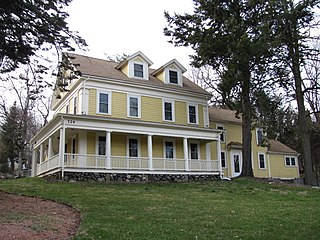
The Nahum Hardy House is a historic house at 724 Lexington Street in Waltham, Massachusetts. The 2+1⁄2-story wood-frame house was built c. 1845, and is a well-preserved local example of a Greek Revival side-hall house. It has a fully pedimented gable end, a full entablature with dentil-like peg moulding, and a single-story porch with Tuscan columns. The corner boards are pilastered. The house stands on land purchased by Nahum Hardy from Harvard College in 1839.
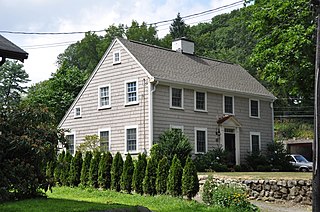
The Frederick Flagg House is a historic house at 65 Fairmont Avenue in Waltham, Massachusetts. It is a 2+1⁄2-story wood-frame structure, four bays wide, with a rear roof sloping down to the first floor in a classic New England saltbox profile. The house was built in 1930 by Frederick Flagg, as a copy of the c. 1710 "Home Sweet Home" house in East Hampton, New York. The principal difference is that Flagg's replica has a more elaborate entry, framed by Doric pilasters and topped by a four-light transom and pediment. Its interior also replicates historic woodwork that was on display in New York's Metropolitan Museum of Art.
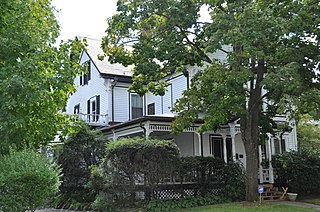
The Henry N. Fisher House is a historic house at 120 Crescent Street in Waltham, Massachusetts. It is a 2+1⁄2-story wood-frame structure, with the asymmetrical massing typical of Queen Anne houses. It has a wraparound porch with turned posts, lattice railing, and a sunburst motif in the gabled pediment above the steps. The interior has well-preserved woodwork and marble fireplaces. The house was built c. 1881–86, and is a well-preserved Queen Anne Victorian on the city's south side. It was home for many years to Henry N. Fisher, who served as city mayor in the late 1880s, and was a foreman at the Waltham Watch Company.

The Dunbar–Stearns House is a historic house at 209 Linden Street in Waltham, Massachusetts. This 2+1⁄2-story wood-frame house was built c. 1846 by Peter Dunbar, and was originally Greek Revival in character. It had a fully pedimented gable, with a single-story porch that was supported by columns that apparently wrapped around the building. The house was purchased in 1892 by Joseph Stearns, who had the house completely remodeled to achieve its present Queen Anne styling. It was enlarged to the sides by incorporating the area of the side porticos, a turret was added to the front, and the pedimented gable was covered with decorative shingle styling. Interior alterations into the new style were equally extensive.
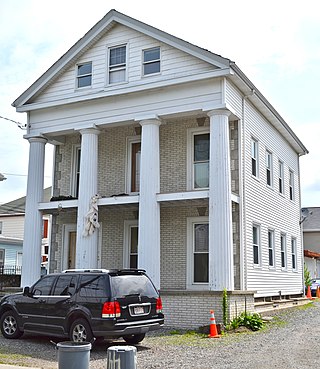
The Francis Buttrick House is a historic house at 44 Harvard Street in Waltham, Massachusetts. Built before 1852, it is one of a small number of temple-front Greek Revival houses in the city. It was listed on the National Register of Historic Places in 1989.

The Josiah Beard House is a historic house at 70 School Street in Waltham, Massachusetts. Built about 1844, it is a well-preserved local example of a side-hall Greek Revival house. It was listed on the National Register of Historic Places in 1989.

The Captain Goodwin–James Eustis House is a historic house in Wakefield, Massachusetts. Built about 1760 and enlarged around 1830, it is a good local example of Greek Revival architecture, which was owned by a prominent local businessman and civic leader. The house was listed on the National Register of Historic Places on March 2, 1990, where it is listed as the "Captain Goodwin–James Custis House".

The House at 309 Waltham Street in Newton, Massachusetts, is a well-preserved high style Greek Revival house. The 2+1⁄2-story house was built c. 1835; it has a classic Greek temple front, with two-story Ionic columns supporting an entablature and pedimented gable, with a balcony at the second level. Single-story Ionic columns support a porch running along the left side of the house. It is one six documented temple-front houses in the city.
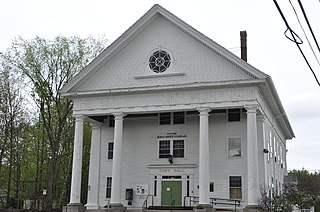
The Bedford Town Hall is located at 70 Bedford Center Road in Bedford, New Hampshire. Built in 1910, it is a prominent early work of Chase R. Whitcher, a noted architect of northern New England in the early 20th century. The building is the third town hall to stand on this site, and was listed on the National Register of Historic Places in 1984.


